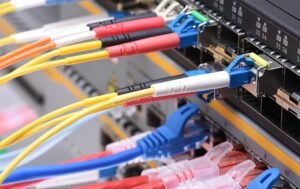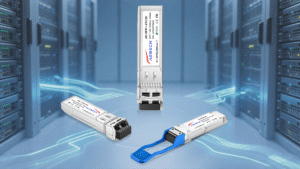What Is BiDi SFP Optical Transceiver
BiDi SFP uses WDM (তরঙ্গদৈর্ঘ্য বিভাগ মাল্টিপ্লেক্সিং) দুই দিকে বিভিন্ন কেন্দ্রীয় তরঙ্গদৈর্ঘ্য প্রেরণ এবং গ্রহণ করার জন্য দ্বি-দিকনির্দেশক সংক্রমণ প্রযুক্তি, এবং একটি অপটিক্যাল ফাইবারে যুগপত দ্বি-দিকনির্দেশক ডেটা ট্রান্সমিশন উপলব্ধি করুন.
BiDi SFP এর শুধুমাত্র একটি LC ইন্টারফেস আছে, যা একটি সমন্বিত দ্বিমুখী কাপলারের মাধ্যমে একটি অপটিক্যাল ফাইবারে অপটিক্যাল সংকেত প্রেরণ করে এবং গ্রহণ করে.
অতএব, আমরা জোড়ায় একক-ফাইবার BiDi SFP অপটিক্যাল মডিউল ব্যবহার করি.
বিঃদ্রঃ: দ্বি-দিকনির্দেশক সহ বর্ণনা, বিডি, একক ফাইবার, একক কোর, WDM, বিএক্স-ইউ, বিএক্স-ডি, ইত্যাদি. BiDi SFP অপটিক্যাল ট্রান্সসিভার বোঝায়.
How Does BiDi SFP Optical Transceiver Work
The main difference between the BiDi SFP optical module and the ordinary SFP optical module is that the BiDi SFP optical module has a built-in wavelength division multiplexing (WDM) coupler, also called a duplexer, which combines and separates the data transmitted on one optical fiber according to different wavelengths.
In order to work efficiently, BiDi SFP optical modules must be used in pairs. By tuning the duplexer to match the desired wavelengths of the transmitter and receiver, the operating wavelengths of the two duplexers must be complementary and identical to achieve Bi-Directional data transmission.
For example, in one pair of 1G BIDI SFP 20KM optical modules, if one side wavelength is Tx-1310nm/Rx-1550nm, another side should be Tx-1550nm/Rx-1310nm. If one side wavelength is Tx-1310nm/Rx-1490nm, another side should be Tx-1490nm/Rx-1310nm. Please note that Tx-1310nm/Rx-1550nm cannot connect with Tx-1490nm/Rx-1310nm.
BIDI SFP Optical Transceivers Applications
BiDi SFP optical modules are usually used in ISP, FTTX, data centers, fiber-to-the-home deployment P2P (point-to-point) connections, and other networks with 1/10/25/50Gbps transmission rate. BiDi SFP optical modules can be installed in switches, fiber optic transceivers, OEO converters, and other equipment to provide high-speed and stable optical transmission.
- For direct connection to switches. A pair of BiDi SFP optical modules are respectively installed on the switches at both ends, and the two BiDi SFP optical modules are connected with LC simplex jumpers to build a link.
- For connecting fiber converters. A pair of BiDi SFP optical modules are respectively inserted into the fiber converters at both ends and connected by a single-mode jumper. At the same time, users use network cables to connect switches and fiber converters. In this way, Ethernet-fiber transmission can be realized
- Used to connect OEO converter. A pair of BiDi SFP optical modules are respectively deployed on the OEO converters at both ends to realize multi-mode-single-mode transmission
The BiDi SFP optical module only needs one fiber, which saves fiber resources and is a better choice for users with insufficient fiber resources.
Ordinary optical modules require 2 optical fibers, but the price is cheaper than single-fiber BiDi SFP optical modules. If the optical fiber resources are sufficient, you can choose ordinary optical modules.
Differences Between BiDi SFP and SFP Optical Transceivers
- BiDi SFP optical module adopts WDM technology, which is not used by ordinary optical modules;
- BiDi SFP optical modules need to be used in pairs, and ordinary optical modules do not;
- BiDi SFP optical module structure has a light splitter and a light combiner, but ordinary modules do not
- BiDi SFP optical module only needs one optical fiber, and the ordinary optical module needs two
- BiDi SFP optical modules are more expensive than ordinary optical modules
- BiDi SFP optical module has only one interface, and ordinary module has two interfaces
Features of BiDi SFP Optical Transceivers
BiDi SFP optical modules can save fiber resources, and the reduction of fibers can reduce the cost of fiber optic cabling infrastructure. BiDi SFP optical modules can reduce the number of ports on the fiber jumper panel, optimize the space occupied by the tray dedicated to fiber management, and reduce the number of optical cables.
Although the price of BiDi SFP optical modules is higher than that of ordinary optical modules, they use half the number of optical fibers per unit transmission distance. For many networks, the cost savings of fewer fibers far outweighs the relatively high purchase price of common optical modules
Aerech BiDi SFP Optical Transceivers Types
1G BiDi SFP
10G BiDi SFP+
10G BiDi XFP
25G BiDi SFP28
Conclusion
BiDi SFP optical modules can support high-bandwidth, low-latency, and high-reliability data transmission, and effectively save fiber resources. It is a practical solution to help users simplify network wiring and increase network capacity. At the same time, the high-speed 25/50G BiDi optical module can provide faster and more stable data transmission for 5G networks, and is a high-quality choice for 5G network deployment. And BiDi dual-fiber Bi-Directional optical module has great potential.



